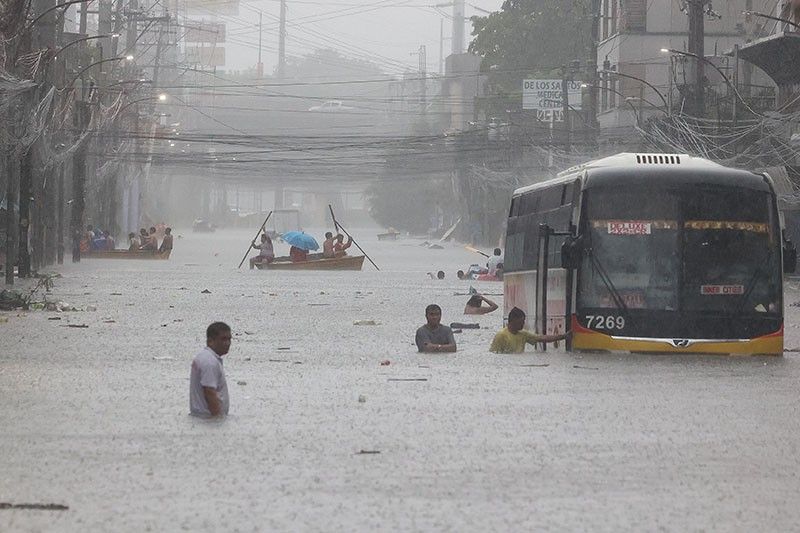by Jan Michael Carpo, Reporter
Super Typhoon Carina, internationally known as Gaemi, wreaked havoc on the Philippine financial markets on Wednesday, compelling the Philippine Stock Exchange (PSE) and various other banking institutions in the county to halt operations due to severe weather and widespread flooding.

The devastation brought about by Super Typhoon Carina along E. Rodriguez Avenue in Quezon City
In the same advisory, the PSE stated that it is announcing a trading suspension “in light of the inclement weather and resulting floods in various areas and localities.” The PSE index stood at 6,753.12 as of the latest trading before the suspension. This precautionary measure aimed to ensure the safety of traders and prevent logistical issues arising from the extreme weather conditions.
Clearing and settlement activities suspended due to Super Typhoon
The Securities Clearing Corp. of the Philippines (SCCP) also suspended clearing and settlement activities due to the Super Typhoon. Transactions logged on July 22 and July 23 are now scheduled to be settled on July 25 and July 26, respectively.
The SCCP assured that “transactions to be effected on July 25, 2024, and onwards shall follow their regular settlement dates,” signalling a return to normal operations once the immediate impact of the typhoon subsides.
The Philippine Dealing System, overseeing fixed income and foreign exchange trading, also halted operations. The peso was trading at P58.435 against the US dollar as of the last closing. This suspension underscores the extensive reach of Typhoon Carina’s impact, affecting not just equities but also other crucial financial instruments.

IMAGE CREDIT: https://www.msn.com/en-ph/money/economy/
Private banks across the country adjusted their operations in response to the heavy rains and flooding. Several branches were closed, and others operated on shortened hours to ensure the safety of employees and customers. Affected banks encouraged clients to use digital platforms for transactions, minimizing the need to visit physical branches.
Super Typhoon halts bank operations, digital transactions
The Land Bank of the Philippines (LANDBANK), for instance, closed some of its branches in Metro Manila due to severe weather. However, several branches in Batangas, Cavite, and Bulacan remained operational, albeit with reduced hours.
Similarly, the Development Bank of the Philippines (DBP) temporarily closed a number of its branches but aimed to maintain service through alternative channels. Earlier this year, the DBP was recognized by an international organization for being ahead of the curve in the sustainability arena as exemplified by its pioneering adoption of green practices in the early 1990s.
The emphasis on digital transactions during this period highlights the growing importance of digital banking solutions in maintaining financial services amid natural disasters. By leveraging online banking platforms, customers can perform essential transactions such as fund transfers, bill payments, and account management without exposing themselves to flooding dangers.
As financial institutions and markets brace for the aftermath of Typhoon Carina, there is a collective effort to ensure operations resume smoothly and efficiently. The PSE and other financial entities have made it clear they will return to their regular schedules as soon as safe. This commitment is vital for maintaining investor confidence and ensuring market stability.
Vulnerability of financial markets in the face of natural disasters
Super Typhoon Carina has demonstrated the vulnerability of financial markets and institutions to natural disasters. The proactive measures undertaken by the PSE, SCCP, and various banks highlight the importance of preparedness and the ability to adapt quickly to unforeseen events.
As the Philippines continues to experience extreme weather conditions, the financial sector’s resilience and flexibility will be crucial in navigating these challenges.
For more updates on the status of financial markets and institutional responses to Typhoon Carina, check out the latest reports here.
The heavy rains brought about by Super Typhoon Carina triggered devastating floods in Manila and nearby provinces, leading to the loss of at least 12 lives and displacing over 600,000 residents. Despite the typhoon not making landfall, it intensified seasonal monsoon rains, causing severe landslides and flooding.
Seeing residents in Marikina and other areas return to their mud-caked homes is a stark reminder of the challenges we now face. At times like these, our resilience and unity as a nation are crucial. Let us all extend our support to those in need and continue to pray for better days ahead.

